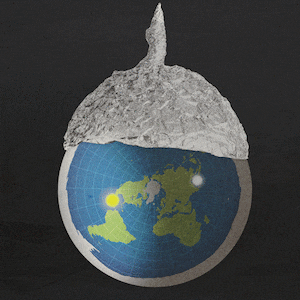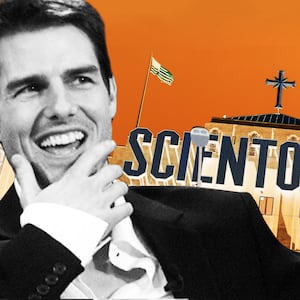Korey Rowe was climbing into the car to report for Army basic training when his best friend stopped him. “He was kind of like, ‘Dude, what are you doing?’” Rowe recalled. “I was like, ‘Don’t worry, man. There's not going to be a war.’”
It was late August 2001. By the end of the year, Rowe was in Afghanistan. Later, he was deployed to Iraq.
“As I traveled from the southern border through Iraq, watching innocent people die who had nothing to do with 9/11 or Afghanistan or Osama bin Laden, my viewpoint on America’s international affairs started to shape very differently,” Rowe told The Daily Beast.
ADVERTISEMENT
By 2005, he was back stateside, disillusioned with the war, and looking for a way to speak out. He began working with Dylan Avery, the childhood friend who had questioned his decision to join the Army. Together they produced “Loose Change”, a megaviral conspiracy documentary about the 9/11 terror attacks. The film—and the broader 9/11 truther movement—put many newfound conspiracy theorists on a path to discover even further fringes: moon landing skepticism, flat earth, and eventually Pizzagate, QAnon, and COVID-19 trutherism.
But neither “Loose Change” nor 9/11 were inevitable conspiracy superspreaders. Instead, the success of 9/11 conspiracy theories was a symptom of disintegrating trust in institutions, and the new profitability of trutherism online. Today Rowe, who made “Loose Change” following his disillusionment in Iraq, is a vocal critic of new theories like QAnon. Meanwhile, the conspiratorial energy that inspired “Loose Change” has spiraled deep into American politics, with big-name truthers like Donald Trump both stoking distrust and reaping its rewards.
American conspiracy theories (and people’s enthusiasm for spreading them) are hardly a new phenomenon. In 1798, for instance, George Washington exchanged a patient series of letters with a fan who insisted he read a book about the Illuminati. (Washington appeared somewhat receptive to the conspiracy theory.) Nor are conspiracy theories a fringe thought pattern, reserved for cranks and paranoiacs. Instead, psychologists argue, conspiratorial thinking is a natural response to fear or uncertainty. Faced with a void of comforting information, we go searching for alternative explanations, many of which support our prior beliefs.
Accordingly, as the Bush administration’s rationale for the Iraq War began to unravel (Iraq did not have weapons of mass destruction, contrary to U.S. claims), suspicion surged around the 9/11 attacks, which many Americans pinpointed as the war’s origin. Though few Americans (approximately 10 percent) believed in 9/11 conspiracy theories immediately after the attack, that number had skyrocketed to 36 percent by 2005. At the time, University of Florida professor and conspiracy theory expert Mark Fenster attributed the new skepticism to growing doubts about the Bush administration and the Iraq War.
“What has amazed me is not that there are conspiracy theories, but that they didn’t seem to be getting any purchase among the American public until the last year or so,” Fenster told Scripps News in 2005. “Although the Iraq war was not directly related to the 9/11 attacks, people are now looking back at 9/11 with much more skepticism than they used to.”
Rowe and Avery were among those skeptics, releasing the first version of “Loose Change” that year. The film, which falsely claimed the 9/11 attacks were actually orchestrated by the U.S. government, became one of the first viral internet videos, despite extensive debunkings by experts.
“It was just huge,” Rowe said of the attention. “It was just crazy. And, you know, we were young, we were 21, 22 and we just kind of were handed the button and we put it on and did the best we could with it.”
Uploaded to Google Video (a proto-YouTube), the film received millions of views, when those numbers were still unheard of. The Google Video service no longer exists and 9/11 truthers are no longer at the forefront of modern conspiracy movements. But the theory’s influence is hardwired into even wilder conspiracy scenes that have emerged in more recent years.
While attending flat earth conferences in 2018 and 2019, multiple movement leaders told me that their first forays into conspiracy theories began with 9/11 trutherism. (“It was pretty pivotal for sure,” one told me of his 9/11 inquiries, which began around the time of the release of “Loose Change.”) The sentiment is common in flat earth social media circles.
“I arrived at Flat Earth last, after investigating many other conspiracies which I often say started with 9/11,” one member of a 15,000-member flat earth Facebook group wrote, “but I suppose it really started with doubts about JFK, and some knowledge about the CIA and the Vietnam war, and subsequent wars.”
“I have been down the rabbit hole since 9-11 and have come to see many things differently. I believe the earth is flat, domed and stationary,” another person posted in an 8,000-member flat earth Facebook group earlier this year.
Big tech algorithms also appeared to learn from the virality (and, by extension, profitability) of early conspiracy videos like “Loose Change.” A 2017 experiment by a Google employee-turned-transparency advocate claimed to show that YouTube recommended a disproportionate volume of conspiracy videos. A 2019 Texas Tech University study of flat earthers found that virtually all had become recent converts via YouTube videos. (YouTube later changed its algorithm to recommend fewer conspiracy clips, specifically 9/11 truther and flat earth videos.)
A man in a different 8,000-member flat earth Facebook group described his own path to flatness as a YouTube-fueled journey launched by 9/11 theories. “As I got older I started looking into more and more things out of my own curiosity (9/11, school shootings),” he wrote. That line of inquiry led him to moon landing theories, which turned into algorithmic recommendations for even stranger beliefs. “Then I saw a video about the flat Earth pop up on my YouTube recommendations.”
Early 9/11 truthers like Rowe and Avery are no longer in control of that conspiratorial momentum. They never were, despite the success of “Loose Change.” Their movement hit critical mass alongside a national wave of distrust of the Bush administration and the Iraq War. The thrust of the nation’s skepticism has shifted, shaped in part by the conspiratorial claims of Donald Trump (who often claimed, incorrectly, to have opposed the Iraq War from its outset).
“We saw the movement kind of splinter in half because there were some people who wanted to look into things like satanic lizard people, and the moon landing, and flat earth and all this nonsense,” Rowe said.
Much as skepticism of the Iraq War ignited 9/11 conspiracy theories on the left, the inverse was playing out on the nativist right. Figures like Trump stoked Islamophobia in the form of conspiracy theories about President Barack Obama’s birth, or in false claims that Muslims in New Jersey celebrated the Twin Towers’ collapse. Far from torpedoing Trump’s presidential hopes, those conspiracy theories helped pave his way to victory with voters whose anxieties—however hateful—had not been catered to by other candidates.
By 2020, when Trump lost re-election, internet-born conspiracy theories had become so central to Trump’s base that the former president was able to falsely claim election fraud, leading to Jan. 6’s attack on the U.S. Capitol by QAnon fans and election-truther militias. An August poll found that two-thirds of Republicans believe the election was “stolen” from Trump.
Though both remain skeptical of the 9/11 attacks, Rowe and Avery have voiced frustration about newer far-right conspiracy theories. (Avery has since produced another 9/11 truther documentary and one of their colleagues, who helped produce later versions of “Loose Change” recently told The New York Times that he believes Trump won the 2020 election.)
Rowe, who once worked on a version of “Loose Change” with Infowars founder Alex Jones, now expresses alarm about Trump’s embrace of Jones on the 2015 campaign trail.
“Trump went on to Alex Jones’s radio show and used that platform to raise a base, which essentially brought him into office,” he said. “President Trump went on national television and every couple of weeks for four years proposed a new conspiracy theory about how the deep state was out to get him, or that COVID is not a problem or that he didn’t lose the election: all these huge, really ridiculous conspiracy theories that were being propagated by the United States president and were being broadcast on international television by our national news organizations.
“So if you want to blame two kids who made an internet documentary 20 years ago for what a president did in the last four years, I don’t think that’s really fair.”







